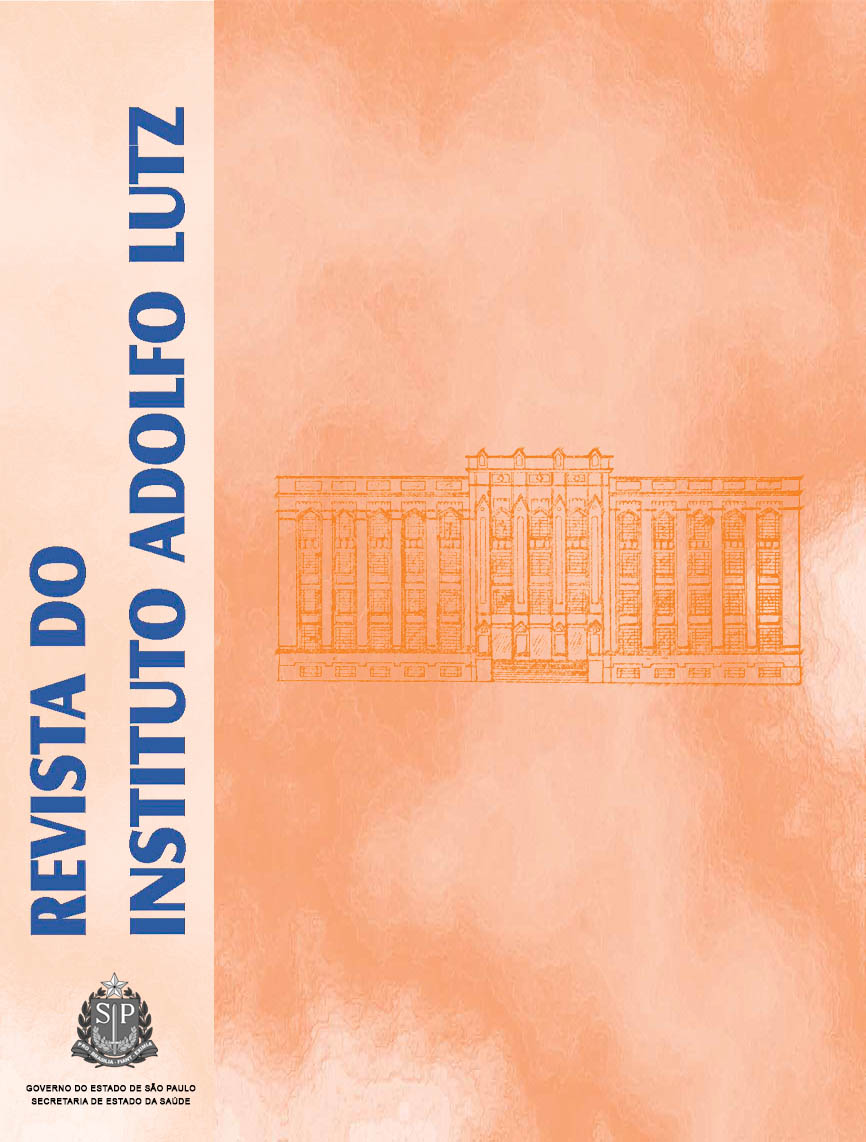Abstract
Pigeons have been considered the reservoirs for infectious agents of public health concern. The deposition of their excreta in public areas can cause environmental contamination, including the food products for human consumption. The purpose of the present study was to investigate the occurrence of Cryptococcus spp and parasites in pigeon excrements. From January to September 2006, sixty eight pools of excreta samples were collected from four public areas of Ribeirão Preto, SP. For detecting Cryptococcus spp, each sample was suspended in saline solution with chloramphenicol, and then cultured on Sabouraud Dextrose Agar plates (SDA) supplemented with chloramphenicol. The cultures were incubated at 30°C and daily observed for seven days. Cryptococcus spp-suggestive colonies were streaked on SDA medium for phenotypic identification. For searching the parasites the spontaneous sedimentation and centrifugal fluctuationin zinc sulfate techniques were carried out. Coccidian oocysts were investigated by formalinether concentration and modified Ziehl-Neelsen staining techniques. Cryptococcus spp was found in 75%, and parasites in 32% of the samples, and the concomitant presence of both pathogens has occurred in 25% of total samples. It is emphasized the establishment of strategies for preserving the public areas by reducing the pigeons populations, in order to avoid environment contamination.References
1. Filiu WFO, Wanke B, Agüena SM, Vilela VO, Macedo RCL, LazeraMS. Cativeiro de aves como fonte de Cryptococcus neoformans nacidade de Campo Grande, Mato Grosso do Sul, Brasil. Rev Soc BrasMed Trop. 2002; 35(6): 591-5.
2. Schüller M. Pesquisa de protozoários e helmintos de interesse médicopresentes nos excretas do pombo doméstico Columba livia domestica. [Dissertação de Mestrado]. São Paulo: Faculdade de Saúde Pública da USP; 2004.103p.
3. Reolon A, Perez LRR, Mezzari A. Prevalência de Cryptococcus neoformans nos pombos urbanos da cidade de Porto Alegre, Rio Grandedo Sul. J Bras Patol Med Lab. 2004; 40 (5): 293-8.
4. Littman ML, Borok AC. Relation of the pigeon to cryptococcosis: natural carrier state, heart resistance and survival of Cryptococcus neoformans. Mycolpathol Mycol Appl.1968; 35(3): 329-45.
5. Fundação SEADE (Fundação Sistema Estadual de Análise de Dados). Informações dos municípios paulistas. Disponível em: <http://www.seade.gov.br> [Acessado em 25 de março de 2008].
6. Pedroso RS. Cryptococcus spp de fontes ambientais em Ribeirão Preto:ocorrência, fatores de virulência e sensibilidade aos antifúngicos. [Dissertação de Mestrado], Ribeirão Preto: Faculdade de Ciências Farmacêuticas de Ribeirão Preto da USP; 2004.
7. Lacaz CS, Porto E, Martins JEC. Micologia Médica: fungos, actinomicetos e algas de interesse médico. 8 ed., São Paulo: Sarvier,1991. 695p.
8 . Lenette EH, Ballows A, Hausler WJ, Shadomy HJ. Manual of Clinical Microbiology, 4th ed., Washington: American Society for Microbiology,1985.
9. Lazera MS, Wanke B, Nishikawa MM. Isolation of both varieties of Cryptococcus neoformans from saprophytic sources in the city of Rio de Janeiro, Brazil. J Méd Vet Mycol. 1993; 31:449-54.
10. Staib F. Saprophytic life of Cryptococcus neoformans. Ann Soc Bel deMéd Trop 1964; 44:611-18.
11. Baroni FA, Paula CR, Silva EG, Viani FC, Rivera ING, Oliveira MTB,Gambale W. Cryptococcus neoformans strains isolated from churchtowers in Rio de Janeiro city, RJ, Brazil. Rev Inst Med Trop. S Paulo2006; 48(2): 71-5.
12. Soares MCB, Paula CR, Dias ALT, Caseiro MM, Costa SOP. Enviromental strains of Cryptococcus neoformans variety grubii inthe city of Santos, SP, Brazil. Rev Inst Med Trop. S Paulo 2005;47(1): 31-36.
13. Lazera MS, Cavalcante MAS, Londero AT, Trilles L, Nishikawa MM,Wanke B. Possible primary ecological niche of Cryptococcus neoformans. Med Mycol Oxford. 2000; 38(5):379-83.
14. Swinne D. Cryptococcus neoformans of saprophytic origin. Sabouraudia Edinburgh 1975; 13:303-8.
15. Johnson LB, Bradley SF, Kauffman CA. Fungemia due to Cryptococcuslaurentii and a review of non-neoformans cryptococcemia. Mycoses.1998; 41:277-80.
16. McCurdy MD, Morrow JD. Ventriculitis due to Cryptococcusunigutulatus. Southern Medical Journal 2001; 94:65-66.
17. Khawcharoenporn T, Apisarnthanarak A, Muny LM. Non-neoformanscryptococcal infectious: a systematic review. Infection. 2007; 35:51-7.
18. Montenegro H, Paula CR. Environmental isolation of Cryptococcusneoformans var. gattii and Cryptococcus neoformans var. neoformansin the city of São Paulo, Brasil. Med Mycol. 2000; 38:385-90.
19. Ruiz A; Vélez D; Fromthing RA. Inovation of saprophyticCryptococcus neoformans from Puerto Rico: distribution and variety.Mycopathology (Den Haag). 1989; 106: 167-70.
20. Yildiran ST; Saracli MA; Gönlün A; Gün H. Isolation of Cryptococcusneoformans var neoformans from pigeon droppings collectedthroughout Turkey. Med Mycol. 1998; 36:391-4.
21. Ishaq CM, Bulmer GS, Felton EG. An evaluation of various environmental factors affecting the propagation of Cryptococcus neoformans. Mycopathology. (Den Haag).1968; 35:81-90.
22. Karanis P, Kourenti C, Smith H. Waterborne transmission of protozoan parasites: a worldwide review of outbreaks and lessons learnt. J WaterHealth. 2007;5(1):1-38.
23. Brasil. Portaria nº 518 de 2004 do Ministério da Saúde. Estabelece osprocedimentos e responsabilidades relativas ao controle e vigilância da água para consumo humano e seu padrão de potabilidade. Diário Oficial [da] União, Brasília, DF, 26 mar. 2004. Seção I, n. 59, p. 266-70.
24. Hunter PR, Thompson RC. The zoonotic transmission of Giardiaand Cryptosporidium. Int J Parasitol. 2005; 35 (11-12):1181-90.
25. Gatei W, Greensill J, Ashford RW, Cuevas LE, Parry CM, Cunliffe NAet al. Molecular analysis of the 18S rRNA gene of Cryptosporidium parasites from patients with or without human immunodeficiency virus infections in Kenya, Malawi, Brazil, the United Kingdom, andVietnam. J Clin Microbiol.2003; 41(4): 1458-62.
26. Xiao L, Bern C, Limor J, Sulaiman I, Roberts J, Checkley W, et al. Identification of 5 types of Cryptosporidium parasites in children in Lima, Peru. J Infect Dis 2001; 183 (3): 492-7.
27. Graczyk TK, Majewska AC, Schwab KJ. The role of birds indissemination of human waterborne enteropathogens. Trends Parasitol.2008; 24 (2):55-9.
28. Ng J, Pavlasek I, Ryan U. Identification of novel Cryptosporidium genotypes from avian hosts. Appl Environ Microbiol. 2006; 72(1):7548-7553.

This work is licensed under a Creative Commons Attribution 4.0 International License.
Copyright (c) 2008 Instituto Adolfo Lutz Journal
